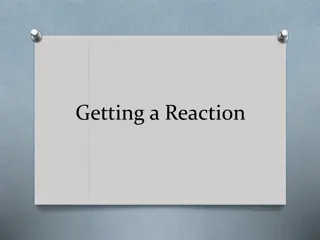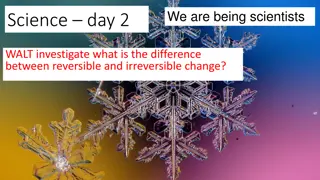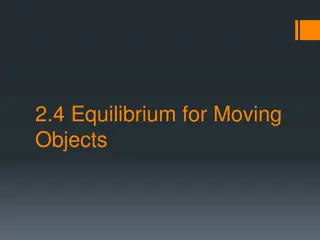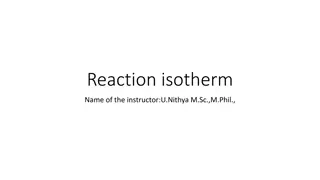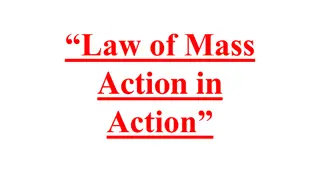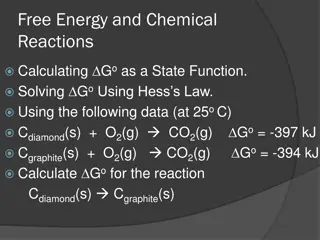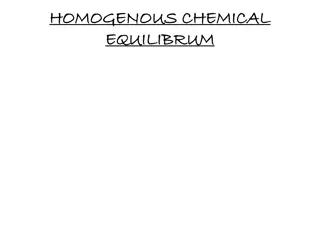Understanding Chemical Equilibrium in Reversible Reactions and Laws
Chemical equilibrium in reversible reactions involves the balance between forward and backward reactions, as governed by laws like the law of mass action and the law of chemical equilibrium. These laws help in understanding the rates of reactions, equilibrium constants, and the relationship between concentrations and pressures in chemical systems.
Download Presentation

Please find below an Image/Link to download the presentation.
The content on the website is provided AS IS for your information and personal use only. It may not be sold, licensed, or shared on other websites without obtaining consent from the author. Download presentation by click this link. If you encounter any issues during the download, it is possible that the publisher has removed the file from their server.
E N D
Presentation Transcript
CLASS XI SUBJECT CHEMISTRY UNIT VII, EQUILIBRIUM (CHEMICAL EQUILIBRIUM) MODULE 2/6
INTRODUCTION: This part of equilibrium includes equilibrium in chemical reactions, law of mass action given by Guldbergand Waagein 1864, law of chemical equilibrium and various relations. It also includes mathematical calculations.
EQULIBEIA INVOLVING CHEMICAL SYSTEM Reversible Reactions:The reactions which proceed in both directions are called reversible reactions. The arrow is two half arrows pointing the reactions in both the directions ( ) eg H2+ I2 2HI State of Chemical Equilibrium:Reversible reactions acquire equilibrium in a close container at a certain conditions.
Law of Mass Action:At a given temperature, the rate of a chemical reaction at any instant is proportional to the product of molar concentration of reactants where the stoichiometriccoefficients are raised in the form of power . This law is applicable to write the law of chemical equilibrium. For a hypothetical reaction, A + B C + D According to this law Rate of reaction [A] [B] Rate of reaction = K [A] [B] Application: This law is applied to write law of chemical equilibrium
Law of Chemical Equilibrium: Consider a hypothetical reaction- A + B C + D According tolawof mass action- Rate of forward reaction [A] [B] Rate of forward reaction = kf[A] [B] Similarly Rate of backward reaction [C] [D] Rate of backward reaction = kb[C] [D]
At equilibrium, Rate of forward reaction = Rate of backward reaction Hence kf[A] [B] = kb[C] [D] Or Where Kc is equilibrium constant Therefore equilibrium constant may be defined as It is the ratio of product of molar concentration of products to that of product of molar concentration of reactants The above expression may be written in terms of pressure when all reactants and products are gases in the reaction. Where Kp is equilibrium constant
Relation between Kp and Kc: Fora hypothetical reaction aA(g)+ bB(g) cC(g)+ dD(g) ----------------(i) We know that PV = nRT( Ideal gas equation) Or P = Or P = cRT equn. I may be written as- Kp =Kc Kp =Kc (RT) (c+d) (a+b) Kp =Kc (RT) n where n = no of moles of products no of moles of reactants
Three cases may arise: a) When n = 0 then Kp = Kc (RT) 0= Kc egH2(g)+ I2(g) 2HI(g) n = 2 (1+1) = 0 b) When n> 0 then Kp>Kc eg PCl5(g) PCl3(g) + Cl2(g) n = 1+1 -1= 1 c) When n< 0 then Kp<Kc eg N2(g) + 3H2(g) 2NH3(g) n = 2 (1+3) = -2
Writing expression of equilibrium constant for the reactions: H2 + I2 2HI iii) CaCO3(s) + Heat CaO(s) + CO2(g) Kp = ( pCO2) Here [CaCO3] = 1 and [CaO] = 1 because they are solid iv) CH3COOC2H5+ H2O CH3COOH + C2H5OH Because [H2O] = 1, it is in excess
Mass Action Ratio (Concentration Quotient) For the reaction, A + B C + D Mass action ratio, Q = This can predict the direction of the reaction. It is the ratio of product of concentration of to that of product of reactant. Q = Qc Or Q = Qp When Q = K, the reaction is at equilibrium When Q > K, the reaction is not at equilibrium. It will proceed towards back word direction When Q < K, the reaction is again not at equilibrium. It will proceed towards forward word direction
Standard Free Energy Change and Equilibrium constant: If G0is the standard free energy change at standard state, the equilibrium constant is related as- G0= -2.303RT log K Standard free energy change may be calculated by the relation- G0= H0-T S0 Where H0is change in standard enthalpy and S0is change in standard entropy.



